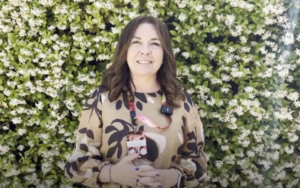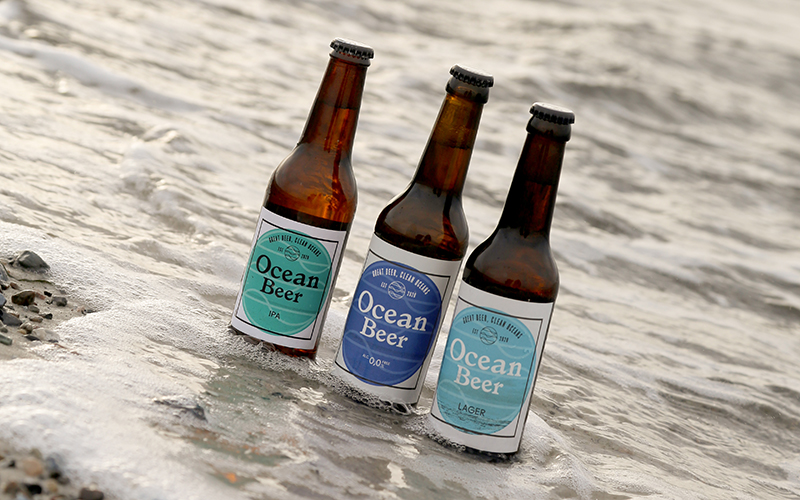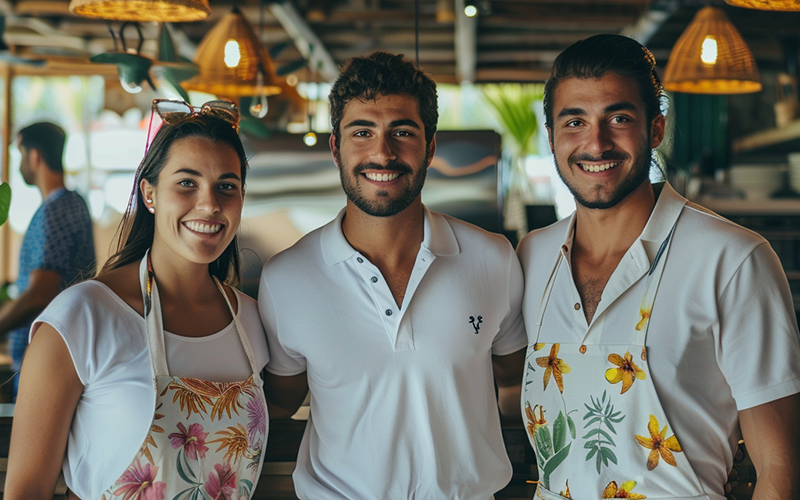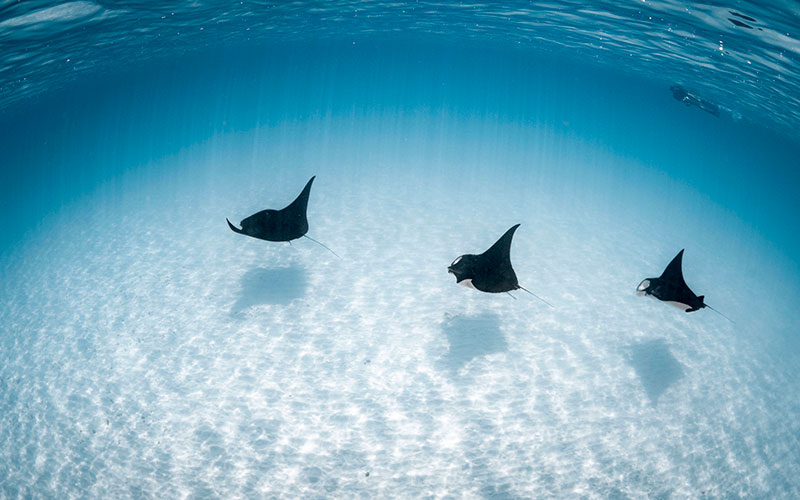Mysterious Risso's dolphins are finally revealing their secrets in the Balearic Islands
June 13th, 2023
Published by: Discover Wildlife
The sun hasn’t yet risen, but all 12 crew on board the Toftevaag are awake and giddy with anticipation. It’s summer 2022, and we’re in the midst of a three-month research season off the Balearic Islands for the Altinak Research Institute. We’re currently sailing within the Cabrera Archipelago National Park, just south of Mallorca, which in 2019 was extended to include almost 90,000ha of open sea. Cabrera Gran, the main island that we departed from, now lies more than 10 nautical miles to the west of our boat, but we are still well within the park’s boundaries.
It isn’t long before we spot a small pod of bottlenose dolphins off our starboard side. They glide and glisten in the dark water just under the bow, almost within reach, staring back at us. Then in perfect synchrony, they veer downwards, quickly fading into the depths.
It’s always a privilege when these curious creatures join our voyage, but bottlenose dolphins are relatively coastal and aren’t our target species. It is a larger and more mysterious cousin of theirs that we seek, a little known denizen of deep waters far from shore. We are in search of Risso’s dolphin, a species that we’ve learned relatively little about since it was first described more than 200 years ago by the French-Italian naturalist whose name it carries: Antoine Risso.
The sun appears, bathing the Toftevaag in a soft golden light. Checking my navigation app, I can see from the contour lines that the water depth is increasing rapidly, from 200m to 800m, and deeper still. We are now crossing over the marine park’s most important feature: the Emile Baudot escarpment, which stretches for 300km all the way to mainland Spain.
These animals lead highly cultural lives that we are only just beginning to comprehend
This is where the continental shelf gives way to the underwater wilderness of the open sea. Plunging down more than 3,000m, the escarpment’s sudden slope has enormous influence over the oceanography and biodiversity of the entire region. The unseen landscape beneath us hosts communities of corals, forests of gorgonians, sedimentary seabeds and many more habitats essential to a community of living beings, of which only a tiny proportion has been documented.
We spend the next few hours searching for dolphins. Eventually, a crew member spies a pod of Risso’s on the horizon, and we alter our course to join them. I am bursting with excitement, since we get to spend precious little time with these animals each year. The Mediterranean population has recently been re-classified by the IUCN as Endangered, based on research in the Corso-Ligurian-Provençal basin, off France and Italy. Studies have shown that, in the past decade, Risso’s have virtually disappeared from these waters, with bycatch topping a long list of threats that could be contributing to this trend. Altinak’s work in the Balearics could prove vital in understanding why Risso’s are disappearing from areas such as this.
Seeing dolphins surface near the Toftevaag always brings a smile to my face. I’m certain some are old friends. Our new volunteers marvel at these large animals, and always comment on their somewhat bizarre and battered appearance. Risso’s are born grey and gradually accumulate white scarring as they age. These scratches, known as rake-marks, are inflicted by members of their own species.
Karin Hartman, an expert on Risso’s dolphins, has filmed large mating ‘orgies’ in the Azores in which dolphins continually scratch each other with their teeth, suggesting the behaviour is connected with breeding. Another scientist, Colin D Macleod, believes the biting has a social function, with the resulting scars serving as an indicator of strength and experience; a signal to fellow dolphins to avoid dangerous confrontations.
The unique patterns of the rake-marks also prove useful to scientists when it comes to individual identification. The scarring is so prominent that we can track individuals via photo-identification rather than using physical tags. With each sighting, we take a photograph and compare it with those in our existing database, which contains more than 250 identified animals. It might turn out to be an individual we know well, such as Pirate, Gigi or Picasso, or it might be a new dolphin, which is then added to the register. Our research is slowly building a picture of the local population – how big it is, how frequently the animals use these waters, which animals spend more time together, how far they roam, and much more.
Suddenly, we experience a special moment. One of the dolphins surfaces, and alongside her is a small, grey calf. A few seconds later, I see another pair. We’ve located a group of mothers and babies, using the waters of the Balearic Islands as a nursery. Young seem to be born at the start of summer, staying with their mothers for the first year, when they are most vulnerable.
A short while later, a dolphin accelerates on the surface. As it gathers speed, it turns sideways before propelling itself downwards at an angle of about 45º, leaving a white trail in its wake. Hartman refers to these as “torpedo” dives, and they indicate that the dolphins are foraging.
Time flies as we get busy observing and recording the dolphins. We strive to keep a respectful distance from the pod, and we seem to be doing a good job, as the animals appear at ease. Eventually, they surround us. We cut the engine and simply drift and watch, the rare combination of optimum sea conditions and relaxed animals allowing for rare encounters. One confident individual torpedo-dives right under the bow; mothers escort their calves directly underneath the ship for a closer inspection. Another hangs vertically in the water, his stocky tail waving about in the air as if saluting us. We don’t know what the behaviour means, but it’s so delightful that I almost want to wave back.
Every moment with these animals is valuable, so we carry on, despite the building afternoon heat. The dolphins continue to forage, but we are frustratingly limited to observing only what happens on the surface, and therefore miss most of the action playing out in the darkness below.
After many hours with these magnificent animals, it’s time to part ways. The sun is beginning to set, giving us respite from the heat. Toftevaag changes her course and heads back to Cabrera Gran – it’ll be another early start tomorrow. I catch one last glimpse of the dolphins slowly disappearing from sight, unaware that they are heading out of the national park.
This encounter with Risso’s was to be one of seven that Alnitak had over the course of the research season. Most of the groups included mothers and calves, and in all groups we witnessed foraging, suggesting that Cabrera Archipelago National Park and its surrounding waters are critical habitat for the species. Some mothers had juveniles that we had seen the previous year, which is a very good sign. Two dolphins (currently known as numbers 12 and 33) have now been sighted five times since 2016. Slowly but surely we are adding to our knowledge of this population.
As I think of how successful this latest encounter has been, I am also reminded these creatures travel vast distances between feeding sites, which exposes them to an array of human-related threats. Some of the pods we’ve encountered swim to the Spanish mainland, to southern France, and across to North Africa, and it’s the latter that spells the most danger.
In the past few years we have been investigating the use of illegal drift nets in the waters off countries such as Morocco and Algeria, and even Italy. Banned in the EU since 2002, these nets can be kilometres long and are often referred to as “curtains of death”. They target species such as tuna and swordfish, but can snare virtually anything, including sharks, manta rays, turtles, dolphins and even whales. In 2022, we sailed into Moroccan waters and witnessed this destructive fishing method for ourselves, finding the remains of a common dolphin that had died from net entanglement. It’s something that Alnitak will be reporting on in future.
Risso’s dolphins know no borders. They do not know where the safe zones are and are unaware of any management or conservation plans intended to help them. Initiatives such as establishing Marine Protected Areas are definitely a step in the right direction, yet these designations can be slow or ineffective, often falling short of their objectives. Depressingly often, a protected area is declared but nothing enforced, hence they are often referred to by conservationists as ‘paper parks’. In the open sea ecosystem, this is even more true.
Undoubtedly, there are challenges ahead, but as we return to Cabrera Gran, I take a look at the volunteers that have joined us for this expedition. They come from different backgrounds and joined us with little idea of what they were letting themselves in for. They are worn out and sunburnt, yet they are uplifted by what they have seen. They want to help, and this fills me with renewed hope.
We know from research on better-known species such as bottlenose dolphins and orcas that these animals lead highly cultural lives that we are only just beginning to comprehend. As time goes on, we are likely to discover similarly complex cultures in Risso’s dolphin society. I’m already looking forward to my next encounter with the dolphins, out in their deep blue world.








